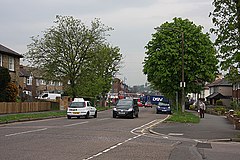Potters Bar
| Potters Bar | |
|---|---|
 The Old Manor, Potters Bar |
|
 Baker Street |
|
| Potters Bar shown within Hertfordshire | |
| Population | 21,639 |
| OS grid reference | TL255015 |
| District | |
| Shire county | |
| Region | |
| Country | England |
| Sovereign state | United Kingdom |
| Post town | POTTERS BAR |
| Postcode district | EN6 |
| Dialling code | 01707 |
| Police | Hertfordshire |
| Fire | Hertfordshire |
| Ambulance | East of England |
| EU Parliament | East of England |
| UK Parliament | |
Potters Bar is a town in Hertfordshire, England, 13 miles (21 km) north of London. In 2011, it had a population of 21,882.
The town dates to the early 13th century but remained a small, mainly agricultural, settlement until the arrival of the Great Northern Railway in 1850. It is now part of the London commuter belt.
The origin of the Potters element of the town's name is uncertain but is generally thought to be either a reference to a Roman pottery, believed to have been sited locally, or alternatively to the Pottere family who lived in neighbouring South Mimms parish. The Bar is thought to refer to the gates leading from the South Mimms parish and into the Enfield Chase parish, or possibly from some sort of toll on the Great North Road, said to have been by what is now the Green Man pub, or at the current entrance to Morven House. See also Temple Bar which is a gate by St Paul's Cathedral.
Potters Bar is located on the Great North Road, one of two road routes from the City of London to the north of England. The road was originally numbered as the A1, and later the A1000.
Potters Bar was historically part of Middlesex and formed the Potters Bar Urban District of that county from 1934. From 1894 to 1934 its area had formed the South Mimms Rural District. In 1965 the district was transferred to Hertfordshire while most of the rest of Middlesex became part of Greater London.
The urban district covered an area of 6,129 acres (24.80 km2). In 1939 it had a population of 13,681, increasing to 24,613 in 1971. In 1974 the urban district was abolished and the area became part of the borough of Hertsmere. Having been part of Middlesex, the area continued to form part of the Metropolitan Police District; with the creation of the Greater London Authority it was transferred to the Hertfordshire Constabulary in 2000.
...
Wikipedia

